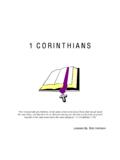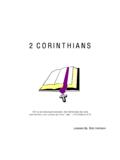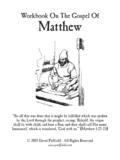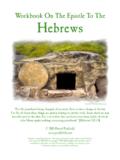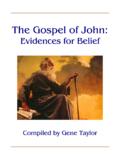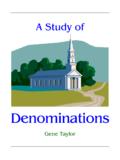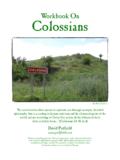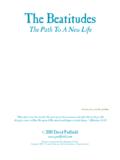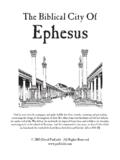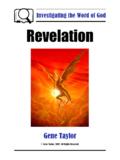Transcription of A Study Outline Of Revelation - Church of Christ
1 A Study Outline of Revelation Town of Skala, Isle of Patmos by James M. Booth 2009 James M. Booth Zion, IL 60099 CONTENTS Page iii I. The Struggle on Earth The Church Persecuted Section 1 Christ in the Midst of the Lampstands Chapter 1 The Revelation of Jesus 1-2 Chapters 2; 3 The Letters to the Seven ;3-1 2;3-7 Section 2 The Book with Seven Seals Chapter 4 The Throne 4-2 Chapter 5 The 5-4 Chapter 6 The First Six 6-5 Chapter 7 An 7-4 Section 3 The Seven Trumpets of Judgment Chapter 8 The Seventh Seal and the First Four 8-5 Chapter 9 First and Second Woes: Fifth and Sixth 9-5 Chapter 10 The Angel, Seven Thunders, The Little 10-3 Chapter 11 The Measured Temple and The Two 11-4 The Third Woe: The Seventh 11-6 II.
2 The Deeper Spiritual Background Section 4 The Woman and the Man Child Chapter 12 The Woman, The Dragon, The Man 12-4 Spiritual War in 12-6 The Persecution of the 12-7 Chapter 13 The Beast out of the 13-5 The Beast out of the 13-7 Chapter 14 The Lamb on Mount 14-2 Angels Warning, A Voice from 14-4 Harvest and Vintage of the 14-6 Section 5 The Seven Bowls of Wrath Chapter 15 The Seven Angels 15-3 Chapter 16 Bowls of Wrath Involving 16-2 Bowls Involving Moral and Political 16-7 CONTENTS Section 6 The Fall of the Great Harlot and Beasts Chapter 17 The Harlot 17-4 The Mystery of the Woman and Beast 17-7 The Harlot Further 17-8 Chapter 18 Fallen, Fallen is 18-3 The Earth Weeps over 18-4 Silence in 18-5 Chapter 19 Victory!
3 The Harlot s Fall and 19-3 The 19-5 The Great 19-6 The Defeat of the Beast and False 19-7 Section 7 The Judgment upon the Dragon The New Heaven and Earth Chapter 20 Satan Bound and the Thousand 20-7 The Final 20-10 Chapter 21 All Things 21-3 The New 21-6 Chapter 22 The New Jerusalem (cont.)..22-1 22-2 22-6 Chart No. 1 Four World Empires Chart No. 2 Comparison of Daniel 7 and Revelation 13 Chart No. 3 The Victory of Christ Chart No. 4 Roman Emperors 1st Century A. D. Map The Seven Churches of Asia Summary The Seven Churches of Revelation Bibliography - i - INTRODUCTION This relatively brief Study Outline with questions and comments is designed to be an introduction to the book of Revelation .
4 It is hoped the student will gain a feeling for apocalyptic writings which are found in Revelation . Apocalyptic literature is a type of writing containing symbols and visions. The book of Daniel is a good beginning in the Study of apocalyptic literature. The first six chapters of Daniel contain some of the best known Old Testament stories: Daniel and the three Hebrew children in Babylon; Shadrach, Meshach and Abednego in the fiery furnace; Belshazzar and the handwriting on the wall; Daniel in the lions den. Beginning in chapter seven apoca-lyptic writings are introduced and continue throughout the remainder of the book.
5 Apocalyptic writings encouraged God s people in times of severe persecution and prepared them for possible future trials. There are three Old Testament apocalyptic books: Ezekiel and Daniel who wrote in the days of Babylonian exile, 605-539 B. C., and Zechariah who prophesied during the Persian era after the return from Babylo-nian captivity, 520 B. C. to an indefinite date. The only apocalyptic book In the New Testament is Revelation which was written by the apostle John during the first cen-tury A. D. In the four gospel accounts, Acts, and the inspired letters, truth is im-parted by words to the mind.
6 In apocalyptic writings, words paint a picture. The pic-ture is not the message; rather the interpretation of the picture is the message. For a better understanding of Revelation , the student is urged to compare various interpretations offered by scholars and to consult different translations of the Bible. This Study is prepared from the New King James Version. Each question can be answered from the Biblical text or the comments offered at the end of each lesson METHODS OF INTERPRETATION OF Revelation Various schools of interpretation of Revelation have evolved throughout the Chris-tian era.
7 Five different methods of interpretation are classified below. Futurist. The book describes events which immediately precede the second coming of Christ . Continuous Historical. The book foretells events from John s writing to the end of time. Philosophy of History. The symbols and pictures described represent forces rather than real events and peoples. Preterist. The book was written and fulfilled in John s day. Historical Background. The book was written for people in John s day with principles applicable to the end of time. This Outline is based primarily on the Historical Background interpretation with the belief that Revelation was written during the reign of the Roman Emperor Domitian, A.
8 D. 81-96. The purpose of the book was to give encouragement to Christians at that time to remain faithful regardless of the severity of their persecutions, even to their physical death. However, some of the prophecies are yet to be fulfilled, and the principles of faith, steadfastness, truth and righteousness remain valid for all time. - ii - THE THEME The theme of the book is the victory of Christ . These will make war with the Lamb, and the Lamb will overcome them, for He is Lord of lords and King of kings; and those who are with Him are called, chosen, and faithful (Rev.)
9 17:14). There pic-tured is a spiritual war between Good and Evil, between Christ and his saints and Satan and his allies. In the end, Christ and the righteous are victorious, while Satan and his followers are utterly defeated and cast into the lake of fire and brimstone to be tormented day and night. See Chart No. 3, The Victory of Christ . SYMBOLISM OF NUMBERS1 In Revelation numbers have a symbolic significance which is consistent with the symbolic language used to describe a picture which in turn must be interpreted for the intended meaning. Thus the numbers do not necessarily have a numerical value, but rather suggest a concept or spiritual truth.
10 For this Study , consider the fol-lowing numbers and their symbolic significance: One represents unity; Two represents strength as two witnesses, or disciples sent out two by two; Three a Divine number as in the Godhead; Four a world number as the four corners of the earth; Six a human number, incomplete or imperfect, less than seven; Seven a complete or perfect number as seven days in a week; Ten represents complete power as ten horns or diadems; Twelve a religious number as twelve tribes or twelve apostles. DIVISION OF THE BOOK2 I. The Struggle On Earth: The Church Persecuted By the World.

